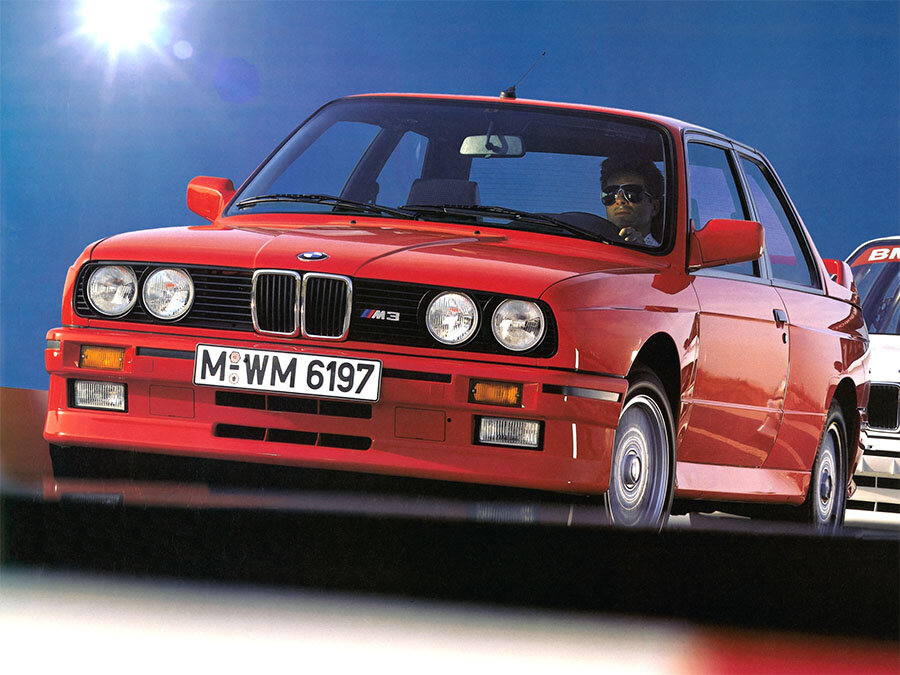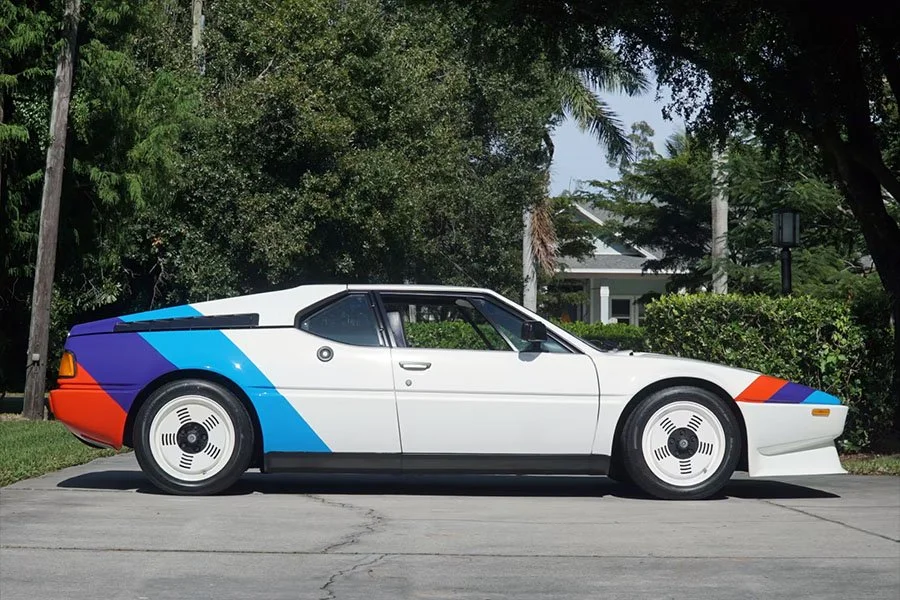Guide: BMW E30 M3 - a Historical & Technical Appraisal
/BACKGROUND
By the mid 1980s, BMW’s Motorsport department had released several production models, but the new E30 M3 would prove to be their most popular yet.
Based on the recently introduced E30 3-series, the M3 was a Group A homologation special.
To qualify for Group A, a production run of 5000 identical road cars within a twelve month period was required. This figure exceeded the capability of BMW’s Motorsport factory in Garching so M3 production took place at the firm’s Munich factory instead.
The drivetrain was built by special teams and then mated to the shell on the regular assembly line.
An exception to this was the M3 Convertible which was released in 1988. Not produced for homologation purposes, the M3 Convertible was assembled at Garching, albeit in much lower numbers than the Coupe.
Coupe production started in September 1986.
Despite its hefty price tag and left-hand drive-only configuration, nearly 18,000 E30 M3s were sold by July 1991 when the last Convertible rolled off the production line.
The M3 Coupe also enhanced BMW’s impressive competition record; it achieved considerable success in Touring Car racing at national, European and world level.
The firm were, of course, no stranger to this discipline of motor sport. Previous models to have won prestigious Touring Car championships included the 1800 TISA, 2002, 3.0 CSL, 320i and 635 CSi.
CHASSIS
BMW started with the standard E30 Coupe’s pressed steel body shell to which a host of special parts were fitted.
The MacPherson strut / semi-trailing arm suspension layout used on all E30s was retained but shorter, stiffer springs, gas-pressurised Boge dampers and thicker anti-roll bars were fitted.
A special Bosch ABS system was also installed and the brake discs were enlarged to 280mm at the front (ventilated) and 282mm at the rear (solid).
Reinforced single piston calipers were sourced from the E28 5-series along with stub axles and wheel bearings.
Track was widened by 5mm at the front and 18mm at the rear.
New 7 x 15-inch BBS alloy wheels were shod with Continental tyres.
A power-assisted quick ratio steering rack was unique to the M3.
A 70-litre fuel tank was installed under the rear seats.
ENGINE / TRANSMISSION
BMW’s S14 four cylinder engine as used by the M3 was created specifically for racing use.
A further development of the two-litre M10 unit designed by Alex von Falkenhausen, it was chosen because of its compact dimensions and high-revving nature.
The S14 combined the basic cast-iron inline four cylinder block from the M10 family with a shortened four valve alloy head derived from the six cylinder M88 and S38 motors.
The S14 engine had individual throttle plates for each cylinder plus siamesed pistons, machined intake and exhaust ports and a crankshaft with eight counterparts. An alloy oil cooler was located behind the front spoiler. Like the M88 and S38 engines, the S14 did not have hydraulic lifters and thus required periodic valve adjustment.
An overall displacement of 2302cc was achieved thanks to a bore and stroke of 93.4mm and 84mm respectively.
Compression was set at 10.5:1 and Bosch Motronic ML fuel-injection was employed.
Without emission controls, the S14 engine produced 200bhp at 6750rpm and 176lb-ft at 4750rpm.
Transmission was via a Getrag 265 close-ratio five-speed gearbox (with a dogleg first), a hydraulic clutch and 25% limited-slip differential.
BODYWORK
Despite obvious visual similarities with the regular E30 Coupe, the M3 only shared a bonnet with its sister variants.
The fenders were widened to accommodate bigger wheels and tyres.
To improve airflow, the rear windscreen was re-angled, the trunk lid was raised and a rear spoiler was installed.
A deep front spoiler and extended side sills were also fitted along with new 2.5mph impact bumpers at each end.
The new body parts were fabricated from SMC composite and contributed to the M3’s reduced 0.33 Cd value (down from 0.38).
To improve rigidity, both the front and rear windscreens were bonded in place.
Other changes included a roof-mounted radio antenna, blacked out Shadowline window frames and M3 badges on the front grille and tailgate.
INTERIOR
Inside, manually adjustable Recaro sports seats were upholstered with houndstooth check cloth centres, plain grey bolsters and PVC backs.
The rear seats were individually contoured.
The standard E30 instrument binnacle was retained albeit with new red needled VDO instruments including a 160mph (260kmh) speedometer and 8000rpm tachometer.
These two large dials were split by a BMW Motorsport logo and an oil temperature gauge which replaced the economy meter that was fitted to the rest of the E30 range.
A three-spoke leather-rimmed M-Tec I steering wheel was also standard along with a Motorsport=branded gear lever, tinted glass and electric door mirrors.
OPTIONS
Optional extras included air-conditioning, electric windows, an electric sunroof, leather upholstery, an on-board computer, cruise control, heated front seats, metallic paint, headlight wash/wipe, rear head rests, velour floor mats, interior headlight adjustment and a choice of audio systems.
WEIGHT / PERFORMANCE
Weight was 1165kg compared to 1209kg for the top-of-the-range 325i.
BMW quoted a top speed of 146mph and 0-62mph time of 6.5 seconds.
LAUNCH
A prototype M3 was displayed at the Frankfurt Motor Show in September 1985 and production began in March 1986.
Group A homologation was approved on March 2nd 1987.
CATALYSED ENGINE
In May 1986, an S14 engine equipped with two inline catalytic converters was released. It produced 195bhp and 170lb-ft at the same engine speeds as before.
The catalysed motor was the only engine used in certain markets.
USA VERSION
After a US-legal iteration of the M3 was unveiled in December 1986, production began in March 1987.
It featured the 195bhp catalysed engine with a different air intake arrangement and a Getrag 260 overdrive gearbox. This ‘box used the standard 325i H-pattern layout and different ratios to Euro spec. M3s.
The US version also came with bumper mounted side marker lights, a third brake light, slightly different headlights, black intake grilles inboard of each front fog light and different instrumentation.
Full leather upholstery, an electric sunroof, air conditioning, the on-board computer, an eight speaker stereo and cruise control were standard.
JAPANESE VERSION
A Japanese market M3 was also produced using the cat-equipped 195bhp motor.
As standard, these cars came with power windows, air conditioning, the on-board computer, an electric sunroof and velour floor mats.
Unlike the US version, they retained the dogleg gearbox of the Euro spec. M3.
100 were built during November and December of 1986 followed by an additional 72 cars between January and June of 1987.
Between September 1987 and March 1989, Japanese market M3s were equipped with the American spec. gearbox. 395 such cars were built.
UK VERSION
Although not available in right-hand drive trim, the M3 was sold in the UK as a special order model and the first official cars arrived in April 1987.
1988 MODEL YEAR
For the 1988 model year, ellipsoid headlights were fitted as standard and a Boge variable Electronic Damper Control system was added to the options list. This offered three settings for the shocks (Sport, Normal and Comfort) and was adjustable via a toggle switch located alongside the handbrake.
E30 M3 CONVERTIBLE
As a result of the Coupe’s popularity, BMW began production of an M3 Convertible in June 1988.
Manufactured at the BMW Motorsport factory, these cars used bodies supplied from the normal E30 assembly line which were sent to Garching where they were fitted with the M3’s special drivetrain, chassis upgrades and interior.
Aside from its bodyshell, the Convertible was mechanically identical to Coupe.
Because of the extra weight (1360kg compared to 1165kg) different spring and shock rates were employed.
A standard E30 boot lid was also used and there was no rear spoiler.
An electric hood and electric windows were standard on the Convertible. A removable hardtop was available via the options list.
M3 Convertible production initially comprised both cat and non-cat Euro market cars.
The first batch were produced between June and September of 1988 followed by a second batch from March until June of 1989.
Production started again in March 1990 and ran until June 1991.
This final batch of M3 Convertibles came equipped with the 215bhp catalysed engine that had become standard equipment on the M3 Coupe in September 1989.
E30 M3 EUROPA MEISTER SPECIAL EDITION
In October 1988, BMW launched the first special edition M3 Coupe.
Built to celebrate victory in the 1988 European Touring Car Championship, the M3 Europa Meister came with a 195bhp catalysed engine, 7.5 x 16-inch alloy wheels, a green-tinted windshield stripe and power windows.
There were also M3 door sill plates, a Motorsport foot rest for the driver and a plaque on the centre console that read ‘Europameister 1988 auf BMW M3’. The plaque was signed by 1988 ETCC champion, Roberto Ravaglia.
150 Europa Meisters were built between October and December of 1988. All were finished in special Macao Blue metallic paint with a Silver extended Nappa leather interior.
Most of these cars were originally sold in Germany and Switzerland.
E30 M3 JOHNNY CECOTTO SPECIAL EDITION
A second special edition M3 followed in April 1989 with the release of the Johnny Cecotto version.
It was the first M3 to get BMW’s improved 215bhp catalysed engine which, in this application, received a body-coloured valve cover. The thinner glass and front and rear spoilers from the Evolution II were fitted along with black-centred 7.5 x 16-inch BBS wheels.
Other standard equipment included half leather seats trimmed in a special anthracite or silver M-Technic cloth, door sill plates with a coloured M3 insignia, a Motorsport footrest for the driver, an illuminated leather shift knob, chrome tail pipes, a green-tinted windshield stripe, electric windows, internal headlight adjustment, on-board computer II and cassette storage box.
480 were built, all of which were painted Nogaro Silver, Macau Blue or Misano Red.
They also came with a plaque on the centre console that bore the production number and signature of Johnny Cecotto.
E30 M3 ROBERTO RAVAGLIA SPECIAL EDITION
At the same time, another 25 cars were built as the Roberto Ravaglia edition for the UK market.
They were identical to the Johnny Cecotto variant in all but name and came in either Misano Red or Nogaro Silver.
MID 1989 PRODUCTION CHANGES
A number of updates were made to the standard M3 in June 1989.
They included new halogen headlights, fixed rear quarter windows, aluminium instead of steel control arms and an enlarged air intake box (as fitted to the Euro spec. Evolution II).
Bigger 7.5 x 16-inch wheels were added to the options list.
215bhp ENGINE BECOMES STANDARD IN EUROPE
From September 1989, Euro spec. M3s were fitted with the new 215bhp catalysed engine as used in the Johnny Cecotto and Roberto Ravaglia special editions.
The increased power was down to reprogrammed Bosch DME. These engines could be distinguished by their BMW Motorsport-liveried collector box and cam covers.
Peak output was 215bhp at 6750rpm and 170lb-ft at 4600rpm.
LATE 1989 PRODUCTION CHANGES
At the same time, a driver-side airbag with knee bolster became standard on US spec. cars and was made optional in Canada.
Other options that were universally made available included a thicker M-Tec II steering wheel and half-leather BMW Motorsport-striped upholstery.
E30 M3 JOHNNY CECOTTO SPECIAL EDITION - SWISS VERSION
Between October and November of 1989 and April and May of 1990, an additional 80 Johnny Cecotto M3s were built for the Swiss market.
Now fitted with the new M-Tec II steering wheel, they came with a Cecotto-signed plaque but were not individually numbered.
END OF PRODUCTION
By the time M3 Coupe production came to an end in December 1990, 15,578 had been completed (not including the 1606 Evolution models which are covered separately).
Production of the Convertible continued until June 1991 and totalled 786 units.
Text copyright: Supercar Nostalgia
Photo copyright: BMW - https://www.bmw.com







































